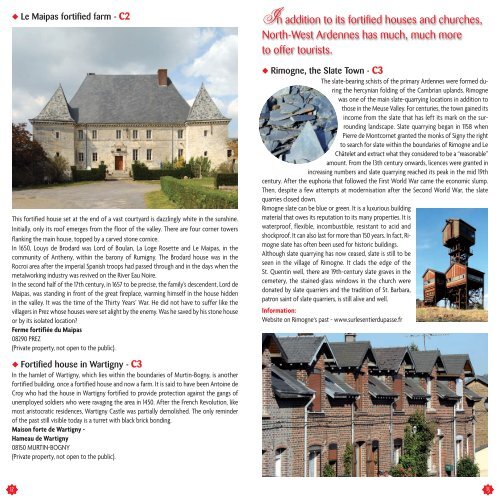La Thiérache – Rocroi Plateau – Sormonne Valley - Office de ...
La Thiérache – Rocroi Plateau – Sormonne Valley - Office de ...
La Thiérache – Rocroi Plateau – Sormonne Valley - Office de ...
You also want an ePaper? Increase the reach of your titles
YUMPU automatically turns print PDFs into web optimized ePapers that Google loves.
◆ Le Maipas fortified farm - C2<br />
This fortified house set at the end of a vast courtyard is dazzlingly white in the sunshine.<br />
Initially, only its roof emerges from the floor of the valley. There are four corner towers<br />
flanking the main house, topped by a carved stone cornice.<br />
In 1650, Louys <strong>de</strong> Brodard was Lord of Boulan, <strong>La</strong> Loge Rosette and Le Maipas, in the<br />
community of Antheny, within the barony of Rumigny. The Brodard house was in the<br />
<strong>Rocroi</strong> area after the imperial Spanish troops had passed through and in the days when the<br />
metalworking industry was revived on the River Eau Noire.<br />
In the second half of the 17th century, in 1657 to be precise, the family’s <strong>de</strong>scen<strong>de</strong>nt, Lord <strong>de</strong><br />
Maipas, was standing in front of the great fireplace, warming himself in the house hid<strong>de</strong>n<br />
in the valley. It was the time of the Thirty Years’ War. He did not have to suffer like the<br />
villagers in Prez whose houses were set alight by the enemy. Was he saved by his stone house<br />
or by its isolated location?<br />
Ferme fortifiée du Maipas<br />
08290 PREZ<br />
(Private property, not open to the public).<br />
◆ Fortified house in Wartigny - C3<br />
In the hamlet of Wartigny, which lies within the boundaries of Murtin-Bogny, is another<br />
fortified building, once a fortified house and now a farm. It is said to have been Antoine <strong>de</strong><br />
Croy who had the house in Wartigny fortified to provi<strong>de</strong> protection against the gangs of<br />
unemployed soldiers who were ravaging the area in 1450. After the French Revolution, like<br />
most aristocratic resi<strong>de</strong>nces, Wartigny Castle was partially <strong>de</strong>molished. The only remin<strong>de</strong>r<br />
of the past still visible today is a turret with black brick bonding.<br />
Maison forte <strong>de</strong> Wartigny -<br />
Hameau <strong>de</strong> Wartigny<br />
08150 MURTIN-BOGNY<br />
(Private property, not open to the public).<br />
12<br />
In addition to its fortified houses and churches,<br />
North-West Ar<strong>de</strong>nnes has much, much more<br />
to offer tourists.<br />
◆ Rimogne, the Slate Town - C3<br />
The slate-bearing schists of the primary Ar<strong>de</strong>nnes were formed during<br />
the hercynian folding of the Cambrian uplands. Rimogne<br />
was one of the main slate-quarrying locations in addition to<br />
those in the Meuse <strong>Valley</strong>. For centuries, the town gained its<br />
income from the slate that has left its mark on the surrounding<br />
landscape. Slate quarrying began in 1158 when<br />
Pierre <strong>de</strong> Montcornet granted the monks of Signy the right<br />
to search for slate within the boundaries of Rimogne and Le<br />
Châtelet and extract what they consi<strong>de</strong>red to be a “reasonable”<br />
amount. From the 13th century onwards, licences were granted in<br />
increasing numbers and slate quarrying reached its peak in the mid 19th<br />
century. After the euphoria that followed the First World War came the economic slump.<br />
Then, <strong>de</strong>spite a few attempts at mo<strong>de</strong>rnisation after the Second World War, the slate<br />
quarries closed down.<br />
Rimogne slate can be blue or green. It is a luxurious building<br />
material that owes its reputation to its many properties. It is<br />
waterproof, flexible, incombustible, resistant to acid and<br />
shockproof. It can also last for more than 150 years. In fact, Rimogne<br />
slate has often been used for historic buildings.<br />
Although slate quarrying has now ceased, slate is still to be<br />
seen in the village of Rimogne. It clads the edge of the<br />
St. Quentin well, there are 19th-century slate graves in the<br />
cemetery, the stained-glass windows in the church were<br />
donated by slate quarriers and the tradition of St. Barbara,<br />
patron saint of slate quarriers, is still alive and well.<br />
Information:<br />
Website on Rimogne‘s past - www.surlesentierdupasse.fr<br />
13


